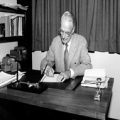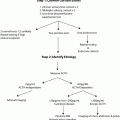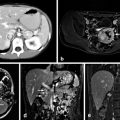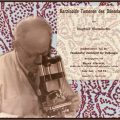Dr. Allen Oldfather Whipple. (Courtesy of Samir Johna, MD)
Introduction
Allen Oldfather Whipple , called Oldfather by his closer friends, was born on September 2, 1881, in Oroomisha, Persia (currently Iran), where his parents were working as missionaries. He was always considered the eldest child because his three older siblings died at the ages of 1, 2, and 3 in Persia. The family moved back to the USA in 1896 with the aim of obtaining a better education for their children [1].
Whipple graduated from Princeton in 1904, and then attended Columbia University’s College of Physicians and Surgeons, becoming a physician in 1908. He then completed a 2-year internship at Roosevelt Hospital in New York [1].
Whipple was appointed chairman of the Department of Surgery at Columbia-Presbyterian with the rank of professor of surgery in 1921, when he was only 39 years old [2]. Over the course of his career, he introduced the concepts of multidisciplinary teams, prospective collection of data for analysis, and critical assessment of postoperative morbidity and mortality. In addition, he made important contributions to the field including a better understanding of neuroendocrine tumors of the pancreas , the development of the Whipple procedure , and insights into portal hypertension [3–6]. He became president of a number of important surgical organizations including the American Board of Surgery and the American Surgical Association. After his retirement in 1946, he completed his career at Princeton where he was a professor of biology and a counselor of students. He died on April 16, 1963, in Princeton, New Jersey. Dr. Allen O. Whipple should be recognized for his tremendous influence in multiple aspects of surgery and for his impact on generations of surgeons.
Living in Persia and His First Years in the USA
Allen Whipple’s parents, William and Mary Louise, graduated from seminary school in Ohio and went to Persia to work as missionaries. They went on a Christian mission and had nine children, four of whom died in Iran. Whipple was born when his parents had been overseas for 9 years, and his family always considered him the eldest child [1].
The Whipples’ stayed in Persia for 25 years in total (1872–1896), with intermittent visits to the USA (1877–1880 and 1889–1890). The young Whipple had several run-ins with medicine including a bout of typhoid fever lasting 2 months and surviving a cholera epidemic in Tabriz that sparked his interest in medicine. However, he first became interested in surgery when his sister had surgery to relieve a small bowel obstruction [1, 2].
Whipple moved back to Oroomiah without his family to attend school in 1894. He lived with the Coans’ family and attended the College Hospital Compound. In 1895, the wife of one of the local physicians died from pneumonia and the Coans (including Whipple) moved into his house to help him. Whipple was greatly impressed with the doctor, not only for his work but also for the compassion and interest he had in his patients. Whipple helped him in his clinical practice and clearly, these activities helped influence his decision to study medicine [1].
The Whipple family returned to the USA to prepare their children for college in 1896. Before leaving Tabriz, they donated all their belongings including their house to create the “Whipple Hospital for Women.” Thus, they traveled with minimal goods, without a lot of money, and were supported by their families and friends after arriving. They settled in Duluth, Minnesota, where they rented half of the house where William’s brother lived [1]. Allen initially attended the Duluth Central High School, where he was seen as a different person because he spoke four languages. The head of his school knew the dean of Princeton and helped Allen to obtain a scholarship to study there.
The Princeton Years (1900–1904)
While at Princeton, Whipple received a full scholarship with a US$ 150 annual stipend. He supplemented the scholarship by tutoring Latin and working at the Princetonian, the college newspaper. Years later, he said that this work gave him the ability to express his ideas adequately [1, 2]. He performed well and was in the upper 20–30 % of his class. Throughout his time at Princeton, he continued to work hard and eventually went on to manage the Robador dinning club, participated in the Colonial Club, and worked at the Blakeley Laundry. He spent the summer in Evanston teaching a classmate and attended the surgical clinic of Dr. Graham, in the afternoons.
He met many important people in his life while at Princeton. In particular, Charles McClure, a professor of biology, became one of his lifelong mentors. Whipple had planned to attend Johns Hopkins Medical School, but Professor McClure arranged for him to attend Columbia University’s College of Physicians and Surgeons with a full scholarship.
Columbia University, College of Physicians and Surgeons (1904–1908)
Whipple continued to excel at Columbia. Of the 160 students in his class, only 79 graduated and Whipple was the third in his class [1]. After graduating medical school, Whipple wanted to continue his training at Roosevelt Hospital, which was the primary teaching hospital of Columbia. He started his residency training on January 1, 1909. However, important changes in the organization of the hospitals occurred during his residency. Abraham Fleuxner conducted studies into the organization of the medical schools of the USA, Canada, and Newfoundland. One of the primary findings was that medical schools should incorporate a teaching hospital when feasible. Roosevelt Hospital was given the option to become the teaching hospital of Columbia University. However, they declined and Columbia subsequently partnered with the Presbyterian Hospital. This decision had an important effect on Whipple, since his surgical mentor, Professor Blake, was transferred to the Presbyterian Hospital. Blake was a senior surgeon, with important experience in and out of the operating room. Despite this setback, Whipple completed 2 years of internship at Roosevelt Hospital even though the standard training included only 1 year of internship. During the first year, he administered anesthetics during the morning, worked in the laboratory, and evaluated patients during the afternoon. He worked as the medical house officer over the next 6 months. During this time, there was a severe epidemic of typhoid fever in New York, and Whipple performed a cholecystectomy on 32 typhoid carriers, interrupting the life cycle of the typhoid Bacillus that harbors in the gallbladder and helping to stop the epidemic [7]. During his second year, he functioned as a surgical intern. However, he never completed a formal training program in general surgery.
Whipple was reunited with his mentor when Professor Blake offered him an academic appointment at his outpatient department as the second assistant attending surgeon. Whipple started on January 1, 1911, and was in charge of the fourth-year clerks. During this time, he worked with Dr. Bill Clarke, who was a surgical pathologist, and participated in research into angiogenesis. He also maintained an outpatient practice in the hospital clinic, worked as a part-time surgical pathologist at Englewood Hospital in New Jersey, and maintained his practice in anesthesia and some practice in obstetrics. However, during this time, he was not performing major surgery.
Notwithstanding, the dean considered him an important part of the academic team and appointed him as a junior attending at the Presbyterian Hospital in 1914. This marked his return to the operating room. He was primarily interested in the surgery of the biliary tract as well as postoperative care, specifically in pneumonia, and published at least one manuscript every year.
His Family
In the spring of 1911, Whipple was invited by a friend to meet two young ladies. Miss Mary Neales was coming to New York to be with her sister. After this initial meeting, the two maintained the relationship, and Dr. Whipple visited her in Boston, when she underwent an appendectomy. They were married on September 26, 1912, at Woods Hall, Massachusetts. They were married for 47 years until her death in February 1959 from a possible myocardial infarction.
They had three children—Mary Allen Whipple (1913–1990) who married Dr. Richard Being, a famous cardiologist; Allen Oldfather Whipple Jr., (1915–1963) who studied history at Princeton; and William Neales Whipple (1917–1933), who was involved in a severe accident near New York. Dr. Whipple was called in to evaluate his son and traveled with him in the ambulance back to Presbyterian Hospital. Unfortunately, he succumbed to his wounds and passed away after emergency surgery.
Contributions to Surgery
Dr. Whipple contributed to the surgical field in many different ways [8–10]. However, he was specifically interested in the spleen (especially the after effects of removal) and portal hypertension, determining that the latter was a consequence of a liver disease. In 1945, he published their experience of 1189 patients treated in 17 years in Annals of Surgery [4].
Much of his research focused on postoperative complications. Indeed, he noticed that many patients developed a particular form of pneumonia after surgery. He studied this finding and wrote a paper called “A study of postoperative pneumonitis.” In this series, 97 of 3719 (2.3 %) patients developed this condition [8]. This was the first study to define postoperative atelectasis and its clinical implications.
Whipple created the first system to record the inpatient and outpatient records into a single document in 1916 and emphasized this comprehensive collection of data in his first paper about pancreatic disease published in 1918. That year he presented a protocol for the collection of information on patients with diseases of the biliary tract and pancreas, which was one of the first prospective protocols.
Stay updated, free articles. Join our Telegram channel

Full access? Get Clinical Tree







